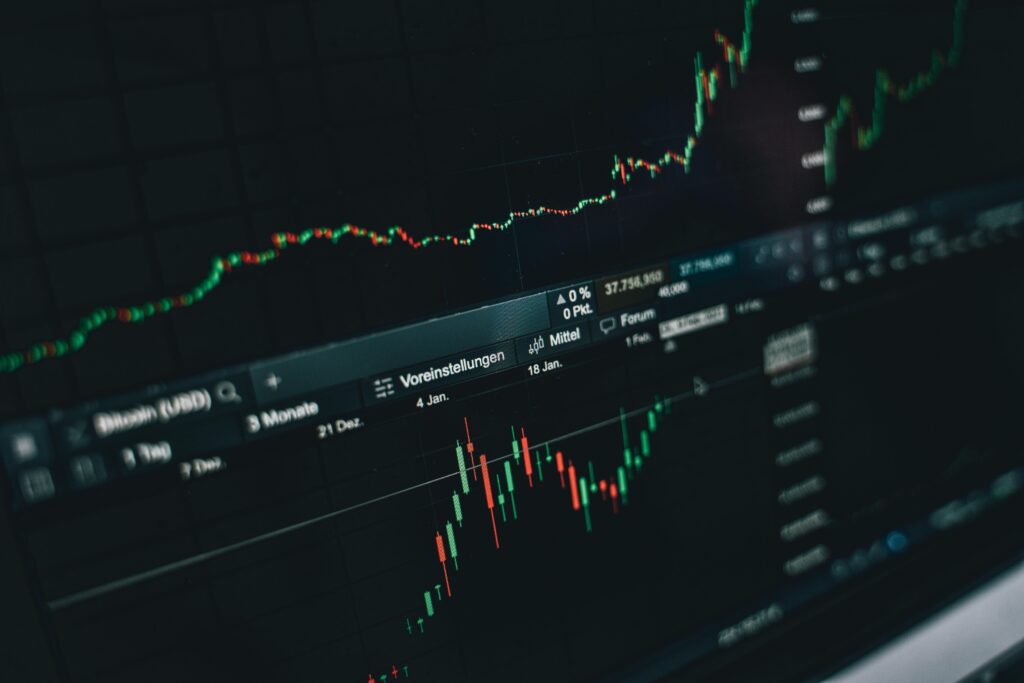Cryptocurrency trading can be a thrilling yet challenging venture, and developing a personalized trading strategy is crucial for success. As the crypto market continues to grow and evolve, many traders are left wondering how to navigate its complexities effectively.Without a well-defined strategy, traders risk making impulsive decisions that could lead to significant losses. In this blog, I will share my journey of creating a successful cryptocurrency trading strategy, detailing the steps I took to understand market dynamics and refine my approach. From setting clear goals to mastering both technical and fundamental analysis, I’ll provide insights that can help you build your own winning strategy. By the end of this article, you’ll have the tools and knowledge to confidently approach the crypto market. Join me as we explore the essential elements of a robust trading strategy!
Setting Your Goals and Risk Tolerance
specific goals: When you enter the market as a beginner, you often have high expectations, thinking that the market will make you rich in just two days. However, these high expectations can quickly lead to demotivation. It’s essential to start with a small capital and set smaller targets. For example, you can use $50 with 3x leverage and set your take profit (TP) and stop loss (SL) at a ratio of 1:2. This way, even if your analysis is wrong, you won’t incur significant losses. By focusing on smaller targets, you can practice your analysis and master your strategy. When you keep achieving small goals, not only will your confidence boost, but each achievement will also motivate you to move forward.”In addition to this, it is very important for you to know some important rules and tips, for which you can read my this article.”
Risk tolerance:
In crypto trading, understanding your risk tolerance is crucial because the cryptocurrency market is highly volatile. A clear grasp of your risk tolerance helps you make informed decisions about how much capital to invest, which assets to trade, and what strategies to employ. It ensures that you can manage stress and avoid making impulsive decisions during market swings, ultimately leading to more disciplined and successful trading outcomes.
Choosing a Trading Style
Before trading, it’s essential to know which trading style you are analyzing in the market. If you are unsure about your trading style or have not yet chosen one, it’s not a problem. I will provide you with complete information about trading styles, which will help you choose your trading style more easily.
1. Day Trading
Definition: Day trading involves buying and selling cryptocurrencies within the same trading day. Traders aim to capitalize on short-term price movements and market fluctuations.
Key Characteristics:
Time Commitment: High traders must monitor the market throughout the day.
Strategy: Requires technical analysis, chart patterns, and real-time data to make quick decisions.
Risk Level: High, due to the volatility of the market. Traders may experience rapid gains or losses.
Profit Goals: Small, consistent profits from multiple trades can accumulate over time.
2. Swing Trading
Definition: Swing trading focuses on capturing gains in a cryptocurrency over a period of days to weeks. Traders look for “swings” in the market and hold positions for a longer duration than day traders.
Key Characteristics:
Time Commitment: Moderate; traders can spend less time daily than day traders, but they need to check the market regularly.
Strategy: Combines technical and fundamental analysis to identify potential price movements and trends.
Risk Level: Moderate; while it reduces the pressure of daily trading, significant price changes can still affect positions.
Profit Goals: Targets larger price movements than day trading, aiming for profits over several days or weeks
3. Holding
Definition: Holding (a misspelling of “holding”) refers to a long-term investment strategy where traders buy and hold cryptocurrencies for an extended period, regardless of market fluctuations.
Key Characteristics:
Time Commitment: Low; once assets are purchased, they are held with little to no active trading.
Strategy: Focuses on the long-term potential of cryptocurrencies, based on belief in the underlying technology and market adoption.
Risk Level: Lower in the short term, as traders are less affected by daily volatility; however, market risks still exist over the long run.
Profit Goals: Aims for substantial long-term gains, often holding through market dips and rallies.
Conducting Market Analysis
To analyze the market, you need to understand technical analysis and fundamental analysis. I will explain what technical analysis is and what fundamental analysis is, so please read the article carefully. You shouldn’t miss any details because without technical and fundamental analysis, you can never become a successful trader
Technical Analysis:
Technical Analysis involves evaluating financial markets through historical price data and trading volume. Traders use various indicators, chart patterns, and tools to make informed decisions about buying and selling assets. Here’s a brief overview of some key components:
1. Key Indicators
- Moving Averages (MA)
- Simple Moving Average (SMA)
- Exponential Moving Average (EMA)
- Relative Strength Index (RSI)
- Moving Average Convergence Divergence (MACD)
6.MACD Line: Difference between the 12-day EMA and the 26-day EMA.
- Signal Line: 9-day EMA of the MACD Line.
2. Chart Patterns
Head and Shoulders:
Definition: A reversal pattern that signals a change in trend direction.
Structure: Consists of three peaks: a higher peak (head) between two lower peaks (shoulders).
Double Top and Double Bottom:
Double Top: A bearish reversal pattern formed after an uptrend, characterized by two peaks at roughly the same price level.
Double Bottom: A bullish reversal pattern formed after a downtrend, characterized by two troughs at approximately the same price level
Triangles:
Symmetrical Triangle: Indicates consolidation and potential breakout in either direction.
Ascending Triangle: Bullish pattern; characterized by higher lows and a horizontal resistance level.
Descending Triangle: Bearish pattern; characterized by lower highs and a horizontal support level.
3. Trading Tools
Volume Indicators:
Definition: Volume indicators show the number of shares or contracts traded in a given time frame. High volume often confirms trends or reversals.
Example: On-Balance Volume (OBV) combines price and volume to show buying and selling pressure.
Bollinger Bands:
Definition: Bollinger Bands consist of a middle band (SMA) and two outer bands (standard deviations). They help identify volatility and overbought or oversold conditions.
Fibonacci Retracement:
Definition: A tool used to identify potential support and resistance levels based on the Fibonacci sequence. Traders often use it to determine reversal points after significant price movements.
Developing Risk Management Rules
Effective risk management is crucial in trading to minimize potential losses and protect profits. Here are some essential risk management tools:
1. Stop-Loss Orders
Definition: A stop-loss order is an instruction to sell a security when it reaches a certain price, limiting the trader’s loss on a position.
Key Features:
Automatic Execution: When the market price hits the stop-loss level, the order is executed automatically, helping traders avoid emotional decision-making.
Types:
Standard Stop-Loss: Set at a specific price point below the entry price for long positions or above for short positions.
Trailing Stop-Loss: Moves with the market price, allowing traders to lock in profits while still providing protection if the price reverses.
2. Position Sizing
Definition: Position sizing refers to determining the amount of capital to allocate to a specific trade based on risk tolerance and account size.
Key Features:
Risk Percentage: A common approach is to risk a small percentage of the trading capital on a single trade (e.g., 1–2%).
Calculation: Traders can calculate the position size using the
Formula:
Position Size = Account Size× Risk Percentage\Dollar Risk per Share
This helps ensure that no single loss will significantly impact the overall portfolio.
3. Profit-Taking Levels
Definition: Profit-taking levels are predetermined points at which traders will close a position to secure profits.
Key Features:
Target Setting: Traders can set specific price targets based on technical analysis, such as resistance levels, Fibonacci retracement levels, or moving averages.
Risk-to-Reward Ratio: Establishing a favorable risk-to-reward ratio (e.g., 1:2 or 1:3) helps traders decide when to take profits while considering the risk taken on the trade.
Building and Backtesting Your Strategy
Formulating a basic trading strategy and testing it with historical data (known as backtesting) is essential for refining your approach before committing real funds. Here’s a guide on how to create, test, and evaluate a basic strategy in crypto trading:
Creating and Testing a Crypto Trading Strategy
- Formulate a Basic Strategy
Market Conditions: Choose trending, ranging, or volatile markets.
Indicators and Timeframes: Select indicators (e.g., Moving Averages, RSI) and timeframe (e.g., daily).
Entry & Exit Rules: Define clear entry and exit signals, like MA crossovers for entries and RSI levels for exits.
Risk Management: Set position sizing and stop-loss limits to manage risk.
- Back testing with Historical Data
Tools: Use Trading View, Crypto Quant, or Meta Trader 5 to test against historical data.
Run Simulation: Back test with specific dates, indicators, and parameters.
Evaluate Performance: Analyze results through metrics like profit/loss, win rate, drawdown, and risk-to-reward ratio.
- Evaluation Tips
Check consistency across market conditions.
Focus on simplicity to avoid overfitting, aiming for a strong risk-to-reward ratio and low drawdown.
By back testing, you refine your strategy, improving its chances of success in live trading.
Practicing with a Demo Account
Starting with a demo account offers several key benefits for new traders:
Benefits of a Demo Account for Crypto Trading
Risk-Free Practice: Test strategies without risking real money.
Strategy Testing: Experiment with different styles and risk management techniques.
Confidence Building: Prepare for real trading’s psychological challenges.
Platform Familiarity: Learn platform tools, charts, and order types.
Recommended Demo Trading Platforms
Binance testnet: Simulate trades with full features.
Trading View Paper Trading: Test strategies with advanced charting.
e Toro: Demo crypto trading with social learning tools.
Crypto.com Demo: Explore markets risk-free.
Bitfinex Paper Trading: Realistic crypto market experience.
Using a demo account builds skills, confidence, and prepares you for live trading.
Developing Emotional Discipline
Emotional discipline helps traders maintain control, even in volatile markets. It’s essential for sticking to a plan, making rational decisions, and avoiding impulsive actions driven by fear or greed.
The Role of Trading Psychology
Trading psychology focuses on managing emotions like fear, greed, and stress, which can heavily influence trading decisions. Poor emotional control often leads to impulsive actions, overtrading, or holding losses too long, ultimately impacting performance.
Tips for Managing Emotions
Set a Trading Plan: Define entry, exit, and risk levels to reduce impulsive decisions.
Stick to Position Sizing Rules: Limit risk per trade to avoid stress from big losses.
Take Breaks: Step away after losses to clear your mind and prevent revenge trading.
Practice Mindfulness: Breathing exercises and short meditations can help manage stress.
Focus on Process, Not Profits: Concentrate on executing your strategy, not just winning.
Controlling emotions is crucial for consistency and long-term success in trading.
Tracking and Refining Your Strategy
Tracking your trades allows you to assess strategy effectiveness and make data-driven adjustments. Regularly refining based on past performance helps improve outcomes over time.
Importance of Keeping a Trading Journal
A trading journal helps track decisions, wins, losses, and key insights. It provides valuable data to evaluate performance, identify patterns, and understand emotional triggers.
Benefits of Regular Review
Optimize Strategy: Adjust based on wins, losses, and changing market conditions.
Identify Weaknesses: Spot recurring mistakes and areas for improvement.
Boost Discipline: Reviewing logs reinforces disciplined decision-making.
Consistently updating and analyzing your journal is essential for refining strategies and achieving steady progress in trading.
Conclusion
Developing a successful cryptocurrency trading strategy requires clear goal setting, understanding market dynamics, disciplined risk management, and continuous strategy refinement. By learning different trading styles, mastering technical and fundamental analysis, and practicing with demo accounts, traders can enhance their skills without financial risk. Tracking trades and managing emotions are equally vital for growth and consistency. Armed with these foundational steps, you’ll be better equipped to navigate the volatile crypto market with confidence and discipline.




